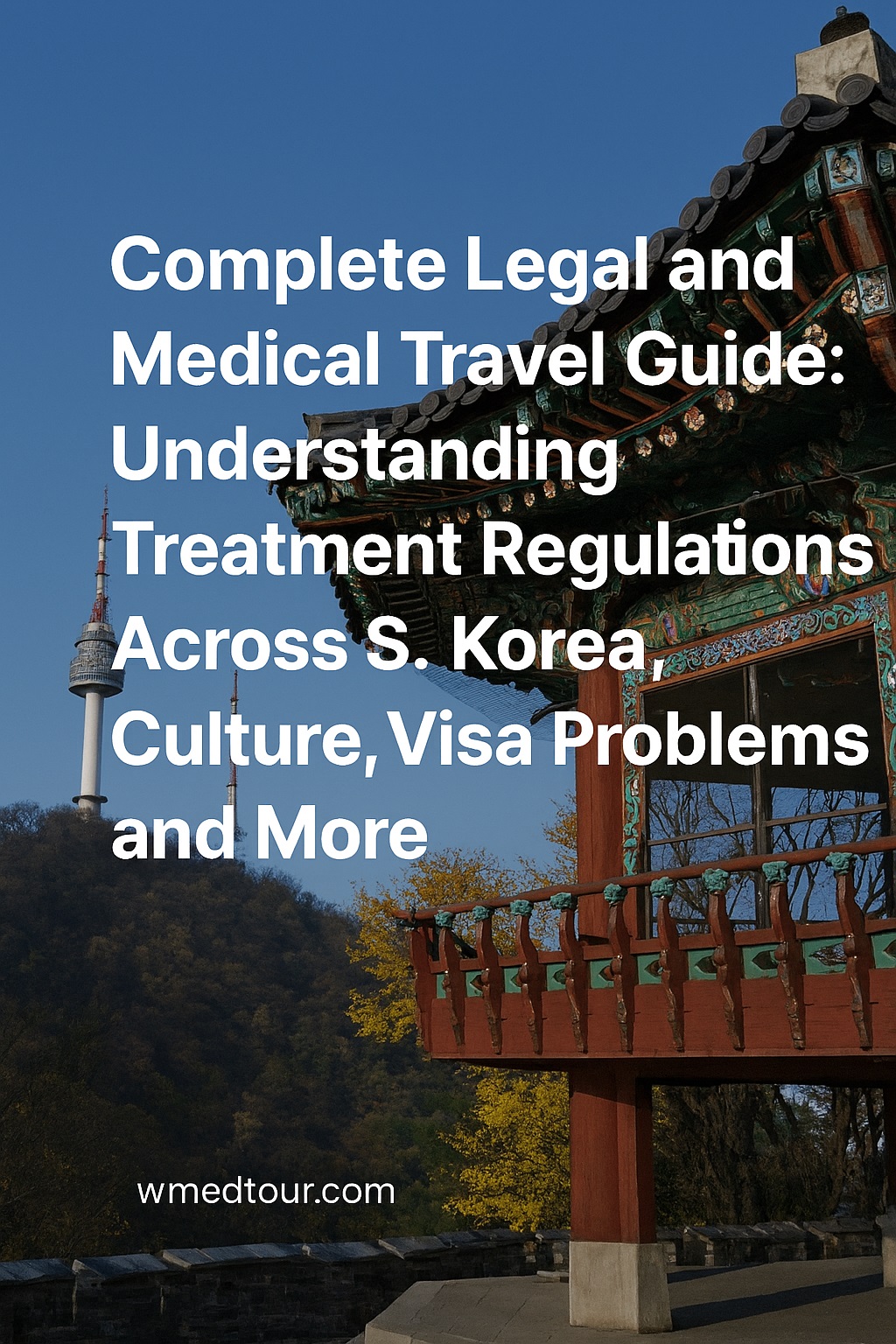The Rise of South Korea in Global Healthcare: A Regulatory Overview for Medical Travelers
In the last decade, South Korea has transformed into a medical superpower, primarily driven by massive government investment in health technology and research. Consequently, it has become one of the most popular destinations for medical tourists seeking services from high-precision robotic surgery to world-class cosmetic treatments. This rapid expansion necessitated a robust regulatory framework. The Ministry of Health and Welfare (MOHW) governs all aspects of medical practice, quality, and international patient enrollment.
Therefore, understanding this regulatory environment is non-negotiable for a safe journey. This **Complete Legal and Medical Travel Guide South Korea** is dedicated to detailing these laws and procedures, ensuring transparency and setting realistic expectations for your trip.
Navigating the Legal Landscape: Treatment Regulations and Patient Safety
South Korean law provides comprehensive protection for both domestic and international patients. Importantly, the Medical Service Act dictates strict standards for facilities, medical staff licensing, and patient information protection. Every hospital that caters to foreign patients must adhere to specialized registration protocols and report patient numbers to the MOHW.
Accreditation and Quality Control: Beyond the Basics of Korean Medical Tourism
When selecting a clinic, international accreditation provides an invaluable layer of assurance. While JCI accreditation is recognized worldwide, South Korea utilizes the **Korean Accreditation Program for Hospitals (KAHF)** as its primary benchmark for excellence. As a result, KAHF-certified hospitals meet stringent criteria regarding patient care, infection control, and administrative efficiency. Furthermore, for highly specialized fields like cancer care, many centers also partner with leading global institutions, reinforcing their status. We recommend checking the accreditation status for any facility you consider on the MOHW’s official directory.
Patient Rights and Medical Liability in South Korea
Korean law ensures patients have a right to full disclosure regarding their diagnosis, prognosis, treatment plan, and costs. Furthermore, informed consent is mandatory and must be documented in a language the patient understands. In cases of medical disputes, the **Korea Medical Dispute Mediation and Arbitration Agency (KOMAD)** provides a streamlined process for resolving complaints without requiring a lengthy judicial procedure. This is a significant advantage over many other countries, offering a clearer path to resolution if problems arise.
Pros and Cons of Korean Medical Regulation
PRO Specialized Arbitration: KOMAD offers a quick, specialized mechanism for dispute resolution, reducing judicial burden.
CON Liability Complexity: Navigating liability can still be difficult without local legal assistance or the hospital’s full cooperation.
CON Documentation: Detailed medical records must be translated and certified, a process that can add time and cost to the trip.
Visa and Logistics: The Medical Traveler’s Trip Blueprint
Securing the right visa is the most critical logistical step in your medical journey to Seoul or any other Korean city. Failure to secure the correct medical visa can result in denied entry or deportation, turning a health trip into a significant problem.
Understanding the C-3-M and G-1 Visas
Medical travel is categorized under two main visa types, depending on the length and severity of the required treatment:
- C-3-M (Short-Term Medical Tourist Visa): This is ideal for quick procedures like rhinoplasty, check-ups, or minor treatments lasting less than 90 days. You must provide an appointment confirmation and a medical expense guarantee from an approved facility.
- G-1 (Long-Term Treatment Visa): Necessary for treatments exceeding 90 days, such as extended oncology care, complex rehabilitations, or high-risk surgeries (like those covered in our heart surgery guide). The G-1 is also often used for those accompanying the patient. This requires far more extensive documentation, including hospital certifications of necessity.
Overcoming Language and Cultural Hurdles
While most major hospitals provide excellent international support, daily life and interactions often present cultural and language problems. The culture is highly hierarchical (based on age and status), and direct confrontation or high emotional display is generally avoided. Therefore, always maintain a respectful distance, use honorifics (which the hospital coordinator can advise on), and channel all complex requests through the appointed liaison.
Pros and Cons of Korean Culture and Logistics
PRO Exceptional Staff Politeness: Hospital staff are known for their high levels of professionalism and courtesy, greatly enhancing the patient experience.
CON Language Barrier: Outside major medical centers, English fluency is low. You will require translation services for daily errands.
CON Formality: The high level of formality can feel restrictive or cold to some Western visitors. Direct feedback is culturally difficult to give.
Specializing in Excellence: Key Treatment Areas Covered by this Guide
South Korea is not a general medical tourism destination; it is a global specialist in certain niches, primarily driven by rapid technological adoption and the sheer volume of cases processed annually.
Aesthetic and Plastic Surgery: The Global Standard
South Korea dominates the world of cosmetic surgery. Regulations are strict, requiring surgeons to be certified by the Korean Society of Plastic and Reconstructive Surgeons (KSPRS). Uniquely, the volume of procedures gives Korean surgeons unparalleled experience, leading to sophisticated, subtle, and highly specific outcomes. This **Complete Legal and Medical Travel Guide South Korea** emphasizes choosing only certified facilities, especially when considering procedures like those detailed in our guides on aesthetic surgeries and top countries for cosmetic procedures.
Advanced Cancer & Complex Surgeries
Beyond aesthetics, Korean hospitals are leaders in oncology, particularly for rare or complex cancers. They utilize cutting-edge technology like proton therapy and robotic surgery. **Furthermore**, the multidisciplinary approach to cancer care is standard, meaning oncologists, surgeons, and radiologists collaborate seamlessly on every case. This commitment to technology makes the country a high-value choice, even compared to high-cost Western markets. Learn more about global cost comparisons in our cancer treatment cost guide.
The South Korean Advantage: Costs, Problems, and Value
When assessing a medical trip, it’s essential to weigh the full spectrum of pros, cons, and financial considerations. While South Korea isn’t the cheapest destination (unlike, for instance, some options discussed in our Iran guide or Turkey guide), it offers unparalleled technological value.
Cost vs. Value Analysis: Finding the Balance
The total cost in South Korea usually falls between that of the USA/Western Europe and Southeast Asian countries. You pay a premium for speed, technological innovation, and specialization. However, the problems can include the high cost of extended stay accommodations and the potential complexity of the G-1 visa process. Consult the hospital’s International Office for a detailed, itemized quote that includes follow-up visits and medications.
Comparison Table: South Korea vs. Key Competitors (Value Drivers)
| Criteria | South Korea | Turkey | USA/Europe |
|---|---|---|---|
| Primary Value Proposition | Highest Tech/Precision & Aesthetics | Cost-Effectiveness & Volume (Aesthetics) | Advanced Research & Insurance Acceptance |
| Accreditation Focus | KAHF & JCI (High Local Standard) | JCI & Ministry of Health (MOH) | National Bodies (e.g., Joint Commission, NHS) |
| Visa Type | Mandatory C-3-M or G-1 Medical Visa | Standard Tourist Visa (Often sufficient) | Varies (Tourist or B-2 Medical) |
| Language Barrier | High (Outside IPD) | Moderate (High in Tourism Zones) | Low (Varies by Region) |
| Key Cost Advantage | Technology is up to 50% cheaper than the USA. | Procedures are up to 70% cheaper than the USA. | Highest costs globally. |
Who is This For?
This **Complete Legal and Medical Travel Guide South Korea** is ideal for a few distinct types of travelers:
- The Aesthete: Individuals seeking highly specialized, advanced cosmetic procedures (e.g., double eyelid surgery, complex body contouring) with the assurance of world-leading expertise.
- The Complex Case Patient: Those requiring advanced treatments like proton therapy for cancer, complex neurosurgery, or specialized organ transplants (subject to legal guidelines). Our guides on prostate cancer treatments and fertility options highlight this specialization.
- The Quality-Driven Traveler: Patients who prioritize the most modern technology and efficient processes above minimum cost savings.
Patient Journey Example: Ms. Lee’s Advanced Check-Up
Case Study: Ms. Lee’s Proactive Health Screening
Ms. Lee, a 55-year-old executive from New York, decided to use her annual leave for a highly detailed health screening, or “check-up,” in Seoul. She applied for the C-3-M Medical Visa, facilitated by the International Patient Department (IPD) of a KAHF-accredited hospital in Gangnam. Firstly, the IPD provided a transparent cost estimate and assisted with her visa letter. Upon arrival, a hospital-contracted interpreter met her at Incheon Airport. Subsequently, her check-up was completed in one day, involving advanced PET/CT scans and specialized genetic testing, procedures that would have taken weeks to schedule in the US. The results were translated and reviewed with a doctor who spoke excellent English. Finally, her short trip was highly efficient and effective, confirming the value of the Korean system for preventative and diagnostic care.
The Regulatory Future: Emerging Trends
The MOHW is continually adapting to the influx of medical tourists. Future trends suggest increased digital integration, with telemedicine regulations likely becoming standardized to accommodate follow-up care for international patients. Moreover, patient privacy laws are expected to tighten further, particularly concerning data sharing between clinics. This dynamic regulatory environment is a net advantage, continually improving the experience for medical travelers. This **Complete Legal and Medical Travel Guide South Korea** will continue to track these evolving standards.
Frequently Asked Questions (FAQ) on South Korea Medical Travel
This section addresses at least 20 of the most pressing questions international patients ask about Korean regulations, culture, and logistics.




